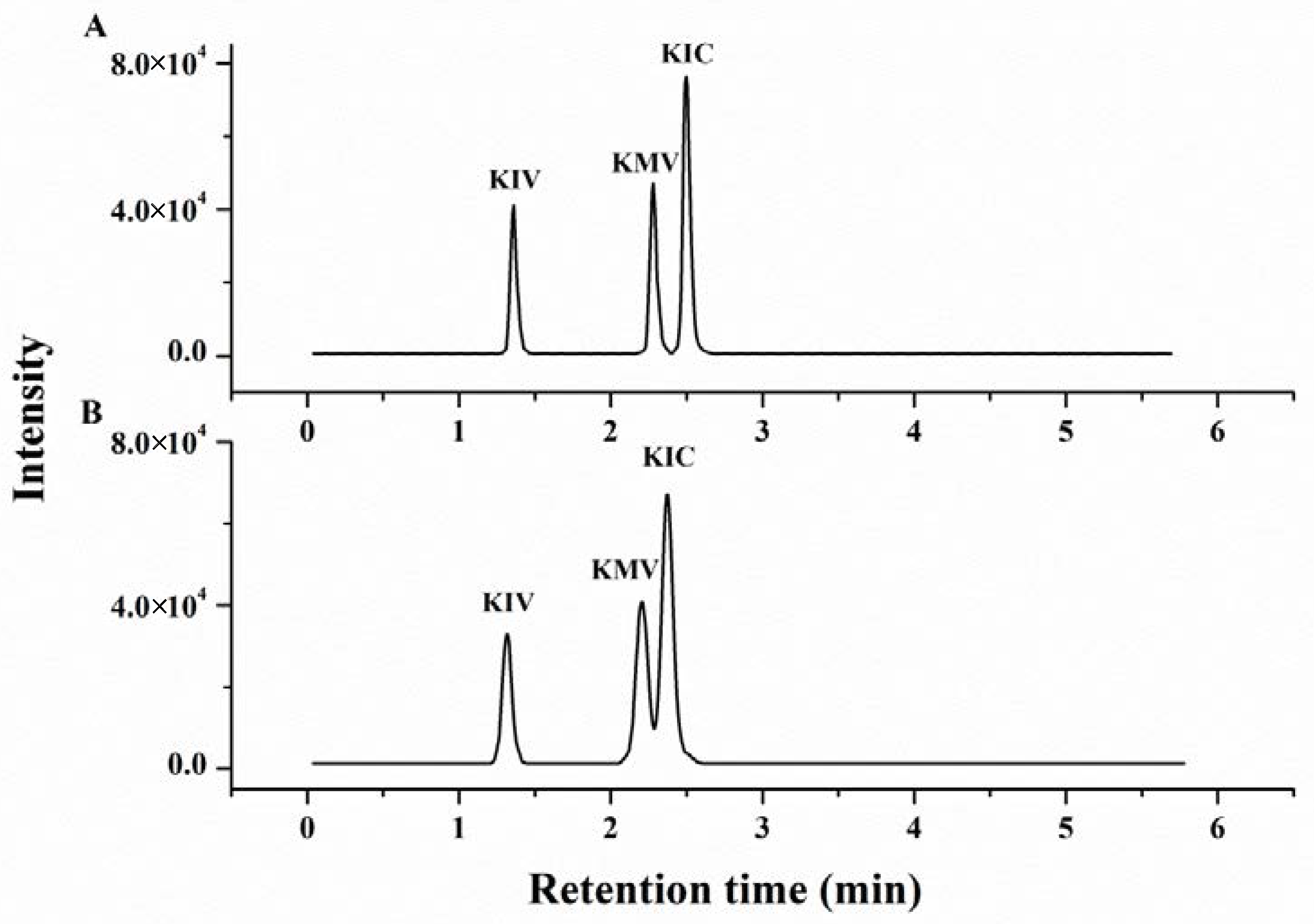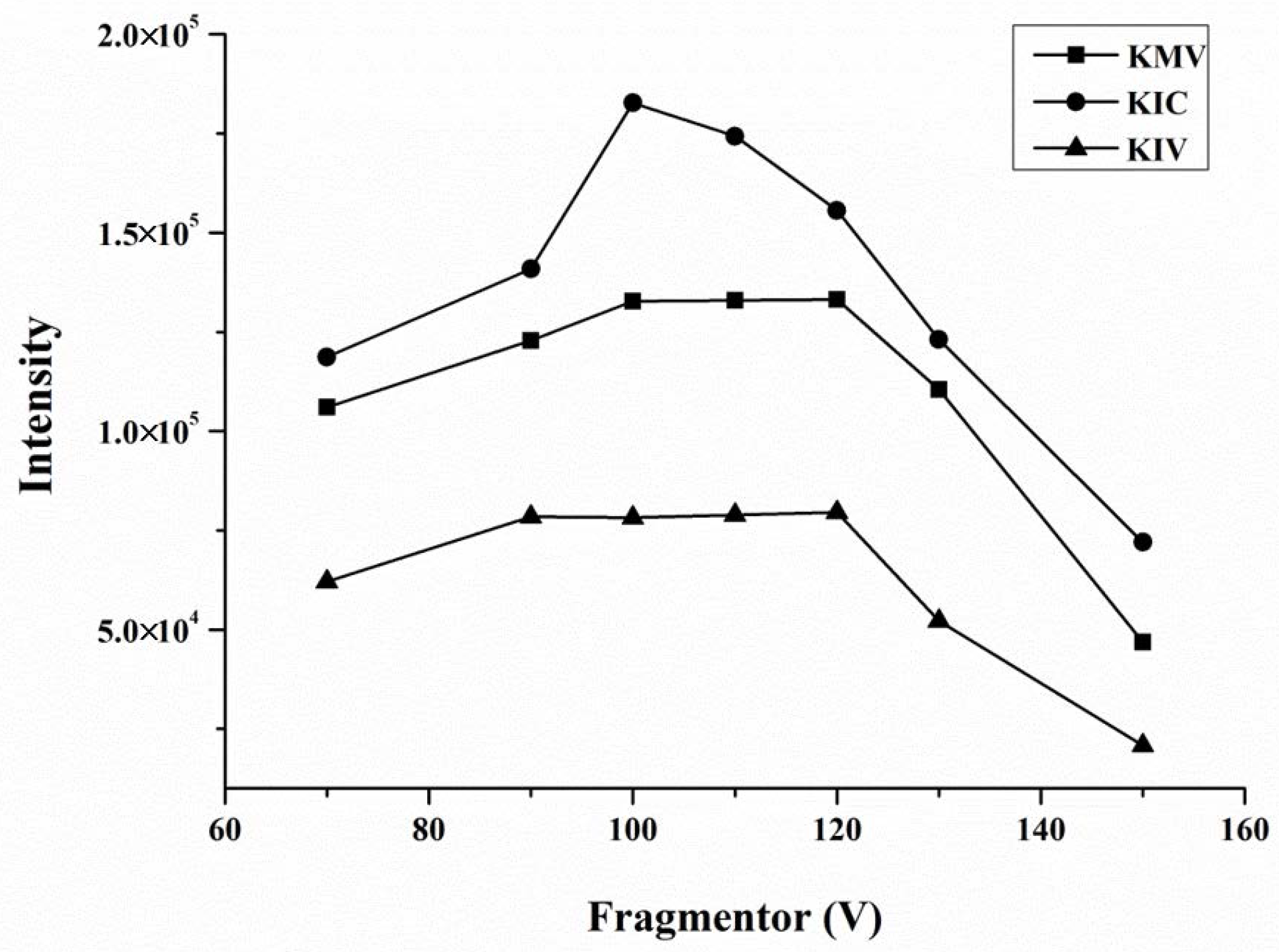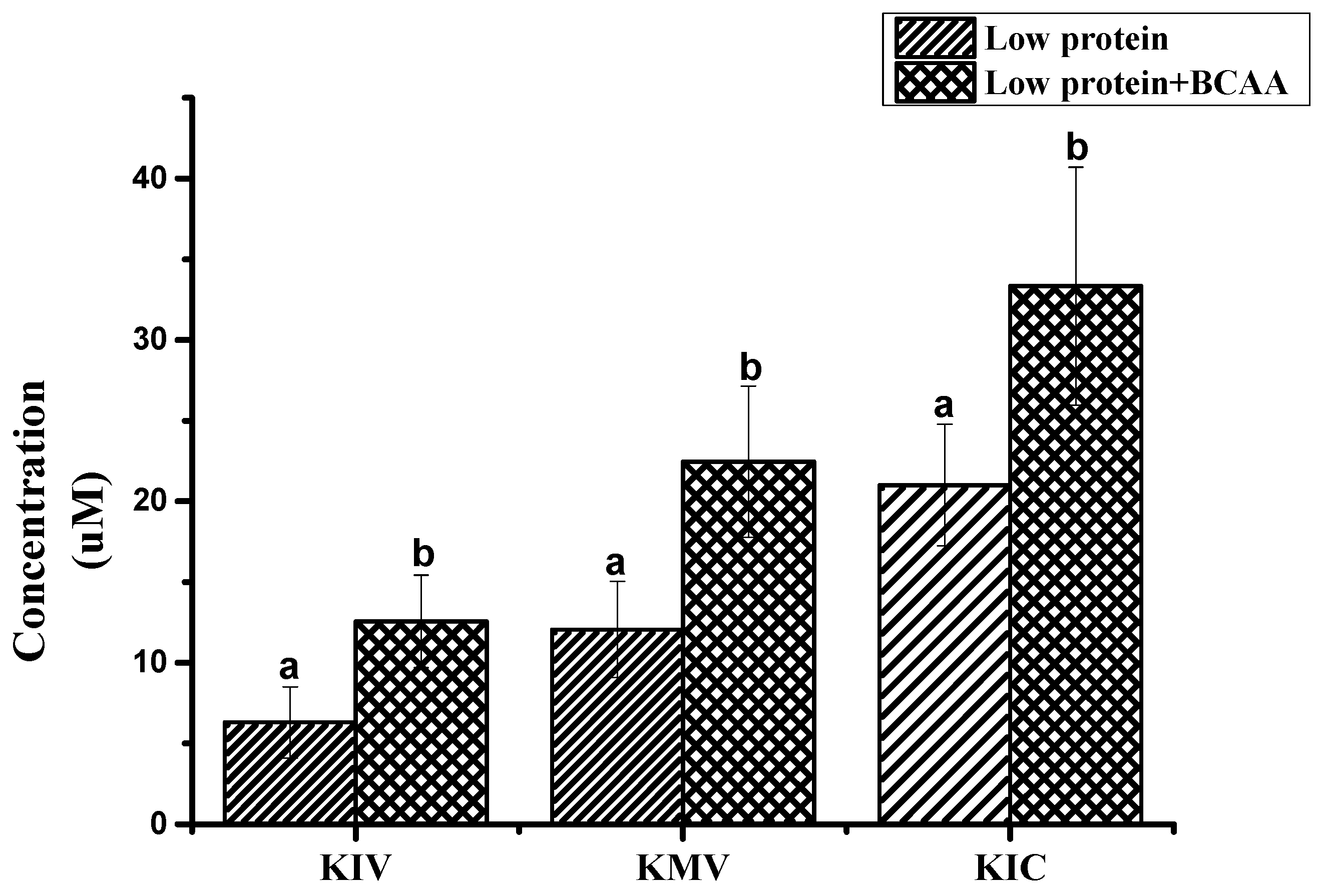Determination of Branched-Chain Keto Acids in Serum and Muscles Using High Performance Liquid Chromatography-Quadrupole Time-of-Flight Mass Spectrometry
Abstract
:1. Introduction
2. Results and Discussion
2.1. Optimization of HPLC Q-TOF/MS Conditions
2.2. Optimization of Pretreatment Conditions
2.3. Method Validation
2.4. The Analysis of Authentic Sample
3. Materials and Methods
3.1. Materials and Reagents
3.2. Apparatus and Procedures
3.3. Preparation of Standard Solutions
3.4. Sample Preparation and Extraction
3.5. HPLC Q-TOF/MS Conditions
3.6. Validation Procedure
3.7. Analysis of Actual Animal Samples
3.8. Statistical Analysis
4. Conclusions
Acknowledgments
Author Contributions
Conflicts of Interest
References
- Tom, A.; Nair, K.S. Assessment of branched-chain amino acid status and potential for biomarkers. J. Nutr. 2006, 136, 324S–330S. [Google Scholar] [PubMed]
- Lynch, C.J.; Adams, S.H. Branched-chain amino acids in metabolic signalling and insulin resistance. Nat. Rev. Endocrinol. 2014, 10, 723–736. [Google Scholar] [CrossRef] [PubMed]
- Lu, J.; Xie, G.; Jia, W.; Jia, W. Insulin resistance and the metabolism of branched-chain amino acids. Front. Med. 2013, 7, 53–59. [Google Scholar] [CrossRef] [PubMed]
- Holecek, M.; Siman, P.; Vodenicarovova, M.; Kandar, R. Alterations in protein and amino acid metabolism in rats fed a branched-chain amino acid- or leucine-enriched diet during postprandial and postabsorptive states. Nutr. Metab. 2016, 13. [Google Scholar] [CrossRef] [PubMed]
- Hattori, A.; Tsunoda, M.; Konuma, T.; Kobayashi, M.; Nagy, T.; Glushka, J.; Tayyari, F.; Cskimming, D.M.; Kannan, N.; Tojo, A.; et al. Cancer progression by reprogrammed BCAA metabolism in myeloid leukaemia. Nature 2017, 545, 500. [Google Scholar] [CrossRef] [PubMed]
- Wilkinson, D.J.; Hossain, T.; Hill, D.S.; Phillips, B.E.; Crossland, H.; Williams, J.; Loughna, P.; Churchward-Venne, T.A.; Breen, L.; Phillips, S.M.; et al. Effects of leucine and its metabolite β-hydroxy-β-methylbutyrate on human skeletal muscle protein metabolism. J. Physiol. 2013, 591, 2911–2923. [Google Scholar] [CrossRef] [PubMed]
- Wisniewski, M.S.W.; Carvalho-Silva, M.; Gomes, L.M.; Zapelini, H.G.; Schuck, P.F.; Ferreira, G.C.; Scaini, G.; Streck, E.L. Intracerebroventricular administration of alpha-ketoisocaproic acid decreases brain-derived neurotrophic factor and nerve growth factor levels in brain of young rats. Metab. Brain Dis. 2016, 31, 377–383. [Google Scholar] [CrossRef] [PubMed]
- Ananieva, E.A.; Van Horn, C.G.; Jones, M.R.; Hutson, S.M. Liver BCATm transgenic mouse model reveals the important role of the liver in maintaining BCAA homeostasis. J. Nutr. Biochem. 2017, 40, 132–140. [Google Scholar] [CrossRef] [PubMed]
- Wang, X.; Wei, H.; Cao, J.; Li, Z.; He, P. Metabolomics analysis of muscle from piglets fed low protein diets supplemented with branched chain amino acids using HPLC-high-resolution MS. Electrophoresis 2015, 36, 2250–2258. [Google Scholar] [CrossRef] [PubMed]
- Zheng, L.; Wei, H.; Cheng, C.; Xiang, Q.; Pang, J.; Peng, J. Supplementation of branched-chain amino acids to a reduced-protein diet improves growth performance in piglets: Involvement of increased feed intake and direct muscle growth-promoting effect. Br. J. Nutr. 2016, 115, 2236–2245. [Google Scholar] [CrossRef] [PubMed]
- Rietman, A.; Stanley, T.L.; Clish, C.; Mootha, V.; Mensink, M.; Grinspoon, S.K.; Makimura, H. Associations between plasma branched-chain amino acids, beta-aminoisobutyric acid and body composition. J. Nutr. Sci. 2016, 5, e6. [Google Scholar] [CrossRef] [PubMed]
- Islam, M.M.; Nautiyal, M.; Wynn, R.M.; Mobley, J.A.; Chuang, D.T.; Hutson, S.M. Branched-chain amino acid metabolon: Interaction of glutamate dehydrogenase with the mitochondrial branched-chain aminotransferase (BCATm). J. Biol. Chem. 2010, 285, 265–276. [Google Scholar] [CrossRef] [PubMed]
- Cole, J.T.; Sweatt, A.J.; Hutson, S.M. Expression of mitochondrial branched-chain aminotransferase and alpha-keto-acid dehydrogenase in rat brain: Implications for neurotransmitter metabolism. Front. Neuroanat. 2012, 6, 18. [Google Scholar] [CrossRef] [PubMed]
- Lee, A.J.; Beno, D.W.A.; Zhang, X.; Shapiro, R.; Mason, M.; Mason-Bright, T.; Surber, B.; Edens, N.K. A 14C-leucine absorption, distribution, metabolism and excretion (ADME) study in adult Sprague-Dawley rat reveals β-hydroxy-β-methylbutyrate as a metabolite. Amino Acids 2015, 47, 917–924. [Google Scholar] [CrossRef] [PubMed]
- Pimentel, G.D.; Rosa, J.C.; Lira, F.S.; Zanchi, N.E.; Ropelle, E.R.; Oyama, L.M.; Oller Do Nascimento, C.M.; de Mello, M.T.; Tufik, S.; Santos, R.V.T. β-Hydroxy-β-methylbutyrate (HMβ) supplementation stimulates skeletal muscle hypertrophy in rats via the mTOR pathway. Nutr. Metab. 2011, 8, 11. [Google Scholar] [CrossRef] [PubMed]
- Green, C.R.; Wallace, M.; Divakaruni, A.S.; Phillips, S.A.; Murphy, A.N.; Ciaraldi, T.P.; Metallo, C.M. Branched-chain amino acid catabolism fuels adipocyte differentiation and lipogenesis. Nat. Chem. Biol. 2016, 12, 15. [Google Scholar] [CrossRef] [PubMed]
- Escobar, J.; Frank, J.W.; Suryawan, A.; Nguyen, H.V.; Van Horn, C.G.; Hutson, S.M.; Davis, T.A. Leucine and alpha-Ketoisocaproic acid, but not norleucine, stimulate skeletal muscle protein synthesis in neonatal pigs. J. Nutr. 2010, 140, 1418–1424. [Google Scholar] [CrossRef] [PubMed]
- Columbus, D.A.; Fiorotto, M.L.; Davis, T.A. Leucine is a major regulator of muscle protein synthesis in neonates. Amino Acids 2015, 47, 259–270. [Google Scholar] [CrossRef] [PubMed]
- Knerr, I.; Weinhold, N.; Vockley, J.; Gibson, K.M. Advances and challenges in the treatment of branched-chain amino/keto acid metabolic defects. J. Inherit. Metab. Dis. 2012, 35, 29–40. [Google Scholar] [CrossRef] [PubMed]
- Crowell, P.L.; Miller, R.H.; Harper, A.E. Measurement of plasma and tissue-levels of branched-chain α-keto acids by gas-liquid chromatography. Method Enzymol. 1988, 166, 39–46. [Google Scholar]
- Fernandes, A.A.; Kalhan, S.C.; Njoroge, F.G.; Matousek, G.S. Quantitation of branched-chain α-keto acids as their N-methylquinoxalone derivatives: Comparison of O- and N-alkylation versus-silylation. Biomed. Environ. Mass Spectrom. 1986, 13, 569–581. [Google Scholar] [CrossRef] [PubMed]
- Pailla, K.; Blonde-Cynober, F.; Aussel, C.; De Bandt, J.P.; Cynober, L. Branched-chain keto-acids and pyruvate in blood: Measurement by HPLC with fluorimetric detection and changes in older subjects. Clin. Chem. 2000, 46, 848–853. [Google Scholar] [PubMed]
- Hara, S.; Takemori, Y.; Yamaguchi, M.; Nakamura, M.; Ohkura, Y. Determination of alpha-keto acids in serum and urine by high-performance liquid-chromatography with fluorescence detection. J. Chromatogr. B 1985, 344, 33–39. [Google Scholar] [CrossRef]
- Anumula, K.R. Rapid quantitative-determination of sialic acids in glycoproteins by high-performance liquid-chromatography with a sensitive fluorescence detection. Anal. Biochem. 1995, 230, 24–30. [Google Scholar] [CrossRef] [PubMed]
- Olson, K.C.; Chen, G.; Lynch, C.J. Quantification of branched-chain keto acids in tissue by ultra fast liquid chromatography-mass spectrometry. Anal. Biochem. 2013, 439, 116–122. [Google Scholar] [CrossRef] [PubMed]
- Yin, B.; Li, T.; Li, Z.; Dang, T.; He, P. Sensitive analysis of 33 free amino acids in serum, milk and muscle by ultra-high Performance liquid chromatography-quadrupole-orbitrap high resolution mass spectrometry. Food Anal. Method 2016, 9, 2814–2823. [Google Scholar] [CrossRef]
- Thakare, R.; Chhonker, Y.S.; Gautam, N.; Alamoudi, J.A.; Alnouti, Y. Quantitative analysis of endogenous compounds. J Pharm. Biomed. Anal. 2016, 128, 426–437. [Google Scholar] [CrossRef] [PubMed]
- Kand’Ar, R.; Zakova, P.; Jirosova, J.; Sladka, M. Determination of branched chain amino acids, methionine, phenylalanine, tyrosine and alpha-keto acids in plasma and dried blood samples using HPLC with fluorescence detection. Clin. Chem. Lab. Med. 2009, 47, 565–572. [Google Scholar] [CrossRef] [PubMed]
- Cree, T.C.; Hutson, S.M.; Harper, A.E. Gas-liquid chromatography of alpha-keto acids: Quantification of the branched-chain-alpha-keto acids from physiological sources. Anal. Biochem. 1979, 92, 159–163. [Google Scholar] [CrossRef]
- Hutson, S.M.; Harper, A.E. Blood and tissue branched-chain amino and alpha-keto acid concentrations-effect of diet, starvation, and disease. Am. J. Clin. Nutr. 1981, 34, 173–183. [Google Scholar] [PubMed]
Sample Availability: Samples of the BCKAs are available from the authors. |






| Compounds | Molecular Formula | Structure | Retention Time (min) | Precursor Ion (m/z) | Fragment Ion (m/z) |
|---|---|---|---|---|---|
| α-ketoisocaproate | C6H10O3 |  | 2.48 | 129.0542 (3.17) a | 59.0158 |
| α-keto-β-methylvalerate | C6H10O3 |  | 2.25 | 129.0542 (3.17) | 68.9959 |
| α-ketoisovalerate | C5H8O3 |  | 1.41 | 115.0391 (2.34) | 59.0126 |
| Compounds | Recoveries (%) | LOQ | ||||||
|---|---|---|---|---|---|---|---|---|
| Serum (μmol/L) | Muscle (nmol/g) | Serum (μmol/L) | Muscle (nmol/g) | |||||
| 10 | 20 | 50 | 1 | 2 | 5 | |||
| α-ketoisocaproate | 114.3 (2.0) a | 84.3 (4.0) | 86.8 (1.9) | 85.9 (6.9) | 93.6 (7.9) | 94.7 (1.6) | 0.06 | 0.09 |
| α-keto-β-methylvalerate | 98.7 (7.6) | 100.2 (4.8) | 99.0 (2.9) | 95.3 (5.4) | 103.2 (9.7) | 100.8 (0.6) | 0.09 | 0.12 |
| α-ketoisovalerate | 89.2 (3.2) | 85.1 (3.8) | 83.1 (1.2) | 82.7 (1.8) | 78.4 (1.0) | 80.0 (7.1) | 0.23 | 0.27 |
| Compounds | Serum (μmol/L) | Muscle (nmol/g) |
|---|---|---|
| α-ketoisocaproate | 27.63 ± 5.39 | 2.61 ± 0.89 |
| α-keto-β-methylvalerate | 18.80 ± 4.92 | 1.45 ± 0.48 |
| α-ketoisovalerate | 10.20 ± 3.94 | 1.24 ± 0.37 |
© 2018 by the authors. Licensee MDPI, Basel, Switzerland. This article is an open access article distributed under the terms and conditions of the Creative Commons Attribution (CC BY) license (http://creativecommons.org/licenses/by/4.0/).
Share and Cite
Zhang, Y.; Yin, B.; Li, R.; He, P. Determination of Branched-Chain Keto Acids in Serum and Muscles Using High Performance Liquid Chromatography-Quadrupole Time-of-Flight Mass Spectrometry. Molecules 2018, 23, 147. https://doi.org/10.3390/molecules23010147
Zhang Y, Yin B, Li R, He P. Determination of Branched-Chain Keto Acids in Serum and Muscles Using High Performance Liquid Chromatography-Quadrupole Time-of-Flight Mass Spectrometry. Molecules. 2018; 23(1):147. https://doi.org/10.3390/molecules23010147
Chicago/Turabian StyleZhang, You, Bingjie Yin, Runxian Li, and Pingli He. 2018. "Determination of Branched-Chain Keto Acids in Serum and Muscles Using High Performance Liquid Chromatography-Quadrupole Time-of-Flight Mass Spectrometry" Molecules 23, no. 1: 147. https://doi.org/10.3390/molecules23010147




